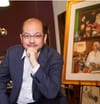- Vision beyond borders: As a media pioneer expanding into South Asia, Woon Tai Ho reflects on digital storytelling, and the enduring need for authenticity in the global age.
- Legacy and vision: The media visionary and author recalls his induction into the Singapore Media Industry Hall of Fame as a milestone achievement.
- Inspiration from reading (Re)Defining Singapore: Woon hopes it can be an invitation to rethink, to reimagine, and to redefine who Singaporeans are and who they want to be.
By Sebastian Lim
AUTHOR and cultural advocate Woon Tai Ho has spent his life telling Asia’s stories — through news, art, and the written word.
In Part 2 of the conversation, Woon reflects on his role in starting Channel NewsAsia and other media ventures as well as the enduring need for authenticity in the global age. Besides his new book, (Re)Defining Singapore, Woon has written several books such as Art of Joy – The Journey of Yip Yew Chong; George Yeo, Selected Musings: Heart and Mind – The World of Edward Tie; Rainbow After Dusk – Lim Tze Peng Remembers, and of course, Soul of Ink – Lim Tze Peng at 100, which won him the Dr Alan HJ Chan Spirit of Singapore Book Prize.

Woon also shares his thoughts on his legacy and hopes that Singaporeans can find recognition and ownership reading (Re)Defining Singapore.
You were instrumental in founding Channel NewsAsia and other regional media ventures. How do you see the evolution of Asian media storytelling over the last 25 years?
For a long time, we were followers of the west, BBC, CNN, CNBC, NewYork Times and Washington Post. What they said were gospel truths, what Russia or China said were propaganda. In the early years of Channel NewsAsia, no one believed we would make it, until they saw and began to appreciate that we were looking at the world for an Asian audience.
People began to appreciate that there was indeed an Asian perspective. For example, the Tsunami in 2004, CNN, BBC and many other powerhouse channels covered the event live over several days. Channel NewsAsia was still in its infancy and we could not match them. Asians followed the disaster on CNN and BBC even though the disaster was a decidedly Asian one.
By the time of the Sichuan Earthquake in 2008, we covered the disaster in a comprehensive manner with correspondents there providing comprehensive live coverage and updates. Our correspondents were bilingual and based in China. They were reporting from ‘home’. Our credibility with our Asian audiences is high because we have more Asian correspondents than any other channel.
Today, Channel NewAsia looks at the world for an Asian audience and speaks with an Asian voice, focused and relevant to its Asian audience. Over time, we slowly learned that every news platform has its own agenda, prejudices and biases. We are now as careful watching CNN as we are CCTV. For Channel NewsAsia, it tries to be as real and honest to its slogan as possible, “We Know Asia”.
In today’s fast-paced digital age, what is the role of integrity and cultural identity in news and entertainment?
In an age when information travels faster than reflection, integrity becomes the anchor that keeps journalism and storytelling credible. Technology has democratised the creation and distribution of content where anyone can publish, everyone can comment. But that same speed often sacrifices accuracy for immediacy, and clicks for truth. Integrity, therefore, is not a nostalgic ideal; it is the moral currency that separates trustworthy voices from the noise. Without it, audiences may be informed but not enlightened. Cultural identity is the soul of any nation’s narrative, it gives context, nuance, and rootedness to what we produce and consume. When entertainment reflects local sensibilities, language, and lived experiences, it deepens understanding and pride rather than mere imitation.

On legacy and vision
Being inducted into the Singapore Media Industry Hall of Fame is a milestone achievement. How do you reflect on that journey from a young broadcaster to a media pioneer?
It feels like a full circle. What kept me grounded was a belief that media is not just about transmitting information, but about shaping imagination, how people see themselves, their community and their country. So this recognition is not so much about me, but about the people and moments that defined Singapore’s media journey. If I have contributed in any way, it’s by helping the next generation see that in the media, as in life, authenticity and purpose never go out of style.
Looking at the next generation of Singaporean storytellers — whether in media, literature, or art — what advice would you give them about staying authentic?
There is only one you, the rest are all taken. Only you can be you, develop that and one day you will be proud of who you are.

When people read (Re)Defining Singapore, what lasting thought or feeling do you hope they walk away with?
I hope they close the book with a sense of recognition, that this is us. Not a perfect Singapore, not a scripted one, but a living, breathing story still being written. If there is one feeling I hope lingers, it’s ownership, that Singapore belongs to all of us, and each of us can help shape what comes next. The book is not an ending; it is an invitation, to rethink, to reimagine, and to redefine who we are and who we want to be.





